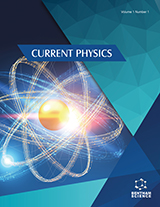Preface
Page: ii-ii (1)
Author: Gennadi Ogurtsov and Danielle Dowek
DOI: 10.2174/9781608052455112010100ii
List of Contributors
Page: iii-iv (2)
Author: Gennadi Ogurtsov and Danielle Dowek
DOI: 10.2174/978160805245511201010iii
Vortices in Atomic Processes
Page: 3-28 (26)
Author: Joseph H. Macek
DOI: 10.2174/978160805245511201010003
PDF Price: $15
Abstract
The time-dependent Schrödinger equation describes dynamical processes of one-electron species in terms of complex wave functions. The functions are inherently complex; therefore zeros occur only when both the real and imaginary parts of the wave functions vanish. If this happens at isolated points rather than on nodal surfaces one can show that the zeros must correspond to vortices. An imaging theorem is given which shows how such vortices can be seen experimentally. Since the theorem requires time propagation from microscopic to macroscopic scales, a method is developed that does just the same. Examples of vortices that emerge in dynamical processes are given. The vortices that we find are linked to the hydrodynamic interpretation of Schrödinger's time-dependent equation.
Interatomic Electronic Decay Processes in Clusters
Page: 29-56 (28)
Author: Vitali Averbukh, Lorenz S. Cederbaum, Philipp V. Demekhin, Simona Scheit, Premysl Colorenc, Ying-Chin Chiang, Kirill Gokhberg, Soren Kopelk, Nikolai V. Kryzhevoi, Alexander I. Kuleff, Nicolas Sisourat and Spas D. Stoychev
DOI: 10.2174/978160805245511201010029
PDF Price: $15
Abstract
Since their theoretical prediction in 1997, Interatomic (intermolecular) Coulombic Decay (ICD) and related processes have been in the focus of intensive theoretical and experimental research. The spectacular progress in this direction has been stimulated both by the fundamental importance of the discovered electronic decay phenomena and by the exciting possibility of their practical application, for example in spectroscopy of interfaces. Interatomic decay phenomena take place in inner-shellionized and inner-shell-excited clusters due to electronic correlation between two or more cluster constituents. These processes lead to relaxation by electron emission and often also to disintegration of the resulting positively charged cluster. Here we review the recent progress in the study of interatomic decay phenomena in excited, singly and multiply charged clusters.
Photoionization Dynamics: Photoemission In The Molecular Frame Of Small Molecules Ionized By Linearly And Elliptically Polarized Light
Page: 57-95 (39)
Author: Danielle Dowek and Robert R. Lucchese
DOI: 10.2174/978160805245511201010057
PDF Price: $15
Abstract
Current results and perspectives on the dynamics of photoionization of small molecules obtained from the analysis of Molecular Frame (MF) photoemission are reviewed. The MF observables intrinsically couple the ionized molecular orbital and the scattering wave function of the photoelectron in the ionization continuum. The field of molecular photoionization has benefited from the development of experimental methods based on the determination of electron-ion momentum vector correlations using position and time sensitive detectors, as well as from advanced ab initio calculations accounting for electronic correlations which influence the different steps of a photoionization reaction. Key features of valence shell and inner shell photoionization processes, involving resonant and non-resonant mechanisms, are illustrated for small molecules of increasing complexity: we emphasize the general formalism which describes molecular frame photoemission for single ionization of linear molecules induced by linearly and elliptically polarized light after one photon absorption, and its extensions to recoil frame photoemission when non-linear molecules or multiphoton processes are considered. The rich information contained in molecular frame photoemission is at the core of a number of recent experiments at the forefront of molecular physics.
Cold Molecules, Photoassociation, Optical Pumping and Laser Cooling: The Cesium Case
Page: 96-121 (26)
Author: Andrea Fioretti, Pierre Pillet and Daniel Comparat
DOI: 10.2174/978160805245511201010096
PDF Price: $15
Abstract
The cold-molecule field concerns the physics and the applications of molecular systems with translational temperature well below the 1 К range. The possibility of controlling all the motion as well as the internal quantum state of a sample of molecules is a long-term goal that opens the possibility for many new experiments and measurements ranging from fundamental constants to quantum chemistry and quantum computation. Although, direct laser cooling of the translational degree of freedom of molecules is still waiting for further technological or theoretical breakthroughs and ideas, many different techniques have proven to be successful in producing different types of cold as well as ultracold (i.e. T < 1 mK) molecules.
In this chapter, we will concentrate on the description of one of these techniques: the photoassociation of laser cooled atoms. We will report on the status of the art of this technique for the case of cesium atoms, describing all the main experimental findings. In particular, we will illustrate the different photoassociation schemes for molecule formation, the detection schemes through photoionization, the molecule trapping in a magnetic or dipolar trap, the vibrational cooling into a single vibrational state and finally the present prospects for rotational cooling.
Introduction
Atomic and molecular physics underlie a basis for our knowledge of fundamental processes in nature and technology and in such applications as solid state physics, chemistry and biology. In recent years, atomic and molecular physics has undergone a revolutionary change due to great achievements in computing and experimental techniques. As a result, it has become possible to obtain information both on atomic and molecular characteristics and on dynamics of atomic and molecular processes. This e-book highlights the present state of investigations in the field of atomic and molecular physics. Recent theoretical developments as well as new discoveries and observations are discussed. The Book should be of interest to students studying atomic and molecular physics and specialists in related fields of science and technology.













